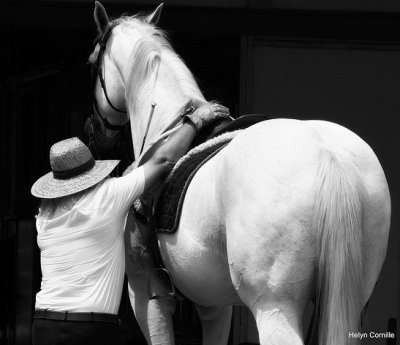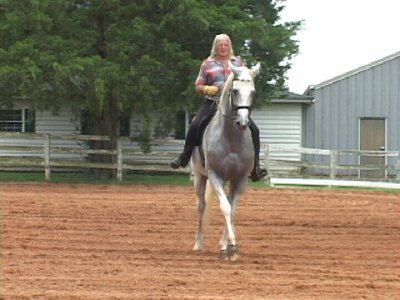Chazot and Jean Luc Thoughts
Chazot and Jean Luc Thoughts
(Jean Luc). While a great defender of the French school, General Decarpentry knew that a school of thought is a limitation, an obstacle to something bigger. As president of the only International dressage jury in 1949, Decarpentry compared skilled riders from different schools. He dreamed about a broader equestrian art and art without frontier, but competition is not about the horse and competition divided. The General was aware of the many blanks in the different schools of thought. He attributed the ability to fill up the blanks to the riders’ skill. “The officer who decides to prepare a horse for international dressage tests is going beyond the limits of his equestrian education.” (Academic Equitation, 1949). The scientific knowledge was elementary, and he could not have understood that the ones who filled up the blanks were, indeed, the horses.
(Chazot) Willingness is part of our Umwelt, but also part of our Umwelt is our will to survive. The combination has led to the most dramatic misunderstanding between humans and equines. Humans have approached us through their myopic lens of self-importance. We are tall and powerful, and by fear, humans resorted to submission. We were willing to do what humans asked but protecting our actual muscle imbalance or other issues. With the mindset on submission. Humans interpreted our errors or protective reflexes, as unwillingness, and instead of analyzing our difficulties and providing solutions, humans reinforced submission. Some of us revolted, as I did, but it was hell until you came and rescued me. Many horses accept slavery as a survival choice.
(Jean Luc) Another reason for the deep-misunderstanding between humans and equines is our naïve belief that you naturally have the solution. Decarpentry defined the aim of academic equitation as restoring to the mounted horse the gracefulness of attitudes and movements which he possessed when he was free. There is a fundamental difference between a move that a horse executes during play and the stylized version of the move required in the show ring while carrying a rider. The natural reflexes are ill-adapted. The evolution of knowledge also exposes more efficient use of your physique. Impact forces, for instance, are traditionally absorbed by eccentric contraction. Propulsive forces are created by concentric contraction. Science has demonstrated that focusing on the cadence and the balance it was possible and more energy-efficient for a horse to use for the propulsion, the elastic energy produced by the eccentric contraction. “The ability of the muscle-tendon units to recover elastic strain energy is apparently energetically so advantageous that the most economical stride frequency in the running may be set by this key component alone.” (Paul C. LaStayo, PT, Ph.D. and all)
(Chazot) When you taught me this technique at the lunge line and riding, I was surprise how easy and comfortable the trot was when I let the elastic energy do the job. It was a valuable lesson. I should say lessons as it demanded practice for me to figure the balance and the cadence where I could optimize storage and reuse of elastic energy. Mentally it was even more important. You showed me that it was a more efficient and easier way. This entered my mind, and I started to look for greater ease and efficiency.
(Jean Luc) I did not teach you how to use greater elastic energy. There is no stimulus or “aid” that could teach that. I created an appropriated situation and let you figure out the benefits of using elastic energy. I slowed the cadence, and when you insisted on trotting faster, I played with many straight lines and circles. Speed is created stiffening the back. Changing the kinematics of your thoracolumbar spine from bending to straight, to bending, to straight makes you abandon the stiffening of your thoracolumbar spine, and you were physically capable of finding your comfortable cadence. This is the conversation that human and equine can have together. I created an appropriated situation, and you explored solutions.
(Chazot)  Comparing our size and weight with human size and weight, humans theorized that we would easily carry your weight. Laws of physics say otherwise. In motion, your weight is multiplied by two to three folds and moving. You are a burden that we negotiate, protecting our weaknesses. We inevitably arrive at a wrong solution, which over time, leads to back pain and other issues. It took hundreds of years of your research to figure the most efficient way for us to deal with the shifts of your body weight. Your academic equitation ignored it and still ignore it. I am 18,1 hands and weight 1800 pounds. You are not very tall and average weight, and you taught me how to carry you. You taught me how to increase the decelerating activity of my hind legs. I became capable of storing more considerable elastic energy and gained the power needed to deal with the addition of your weight. You educated my back muscles, making me discover that I could convert through the work of my back muscles, the propulsive thrust of my hind legs into greater upward forces. Not only you taught me how to carry you, but I realized that the work of my back muscles allowed me to control my balance. I also realized that by reducing the load on my forelegs I was capable of producing greater upward forces with my front limbs. You did not ask forward movement; you teach me how to improve my cycle of locomotion. I am a born average mover moving like a world-class mover, and the whole education has been a partnership where you created situations encouraging my mind to explore. I discovered coordination of my physique that I did not know I was capable of.
Comparing our size and weight with human size and weight, humans theorized that we would easily carry your weight. Laws of physics say otherwise. In motion, your weight is multiplied by two to three folds and moving. You are a burden that we negotiate, protecting our weaknesses. We inevitably arrive at a wrong solution, which over time, leads to back pain and other issues. It took hundreds of years of your research to figure the most efficient way for us to deal with the shifts of your body weight. Your academic equitation ignored it and still ignore it. I am 18,1 hands and weight 1800 pounds. You are not very tall and average weight, and you taught me how to carry you. You taught me how to increase the decelerating activity of my hind legs. I became capable of storing more considerable elastic energy and gained the power needed to deal with the addition of your weight. You educated my back muscles, making me discover that I could convert through the work of my back muscles, the propulsive thrust of my hind legs into greater upward forces. Not only you taught me how to carry you, but I realized that the work of my back muscles allowed me to control my balance. I also realized that by reducing the load on my forelegs I was capable of producing greater upward forces with my front limbs. You did not ask forward movement; you teach me how to improve my cycle of locomotion. I am a born average mover moving like a world-class mover, and the whole education has been a partnership where you created situations encouraging my mind to explore. I discovered coordination of my physique that I did not know I was capable of.
(Jean Luc) When we recorded the video for the study of the dynamics of half pass, the interaction of forces changed consistently related to the position of each of your limb in relation to your body At one instant, one hind leg was in the propulsive phase, one foreleg was is in the decelerating phase, one into the swing. The next moment, limb position and action changed. You had to continually manage the forces keeping the bending of your thoracic spine as well as the proper rotation. At one instant, you needed support on my left upper thigh or calf. I needed to resist the bending of my vertebral column, which would have altered your research. We talked together very fast, but very soft. It was at the level of energy, subtle increase, or decrease of tone while maintaining the integrity of our physiques. At one moment, you found optimum efficiency. You processed optimum use of elastic energy. You added then your style; It was effortless, it was delightful. I was ready to say thank you and reward, but you kept going at ease, powerful, rhythmic. You enjoyed it as much as I did.
(Chazot) I did not need your reward; I knew that it was good; it was easy. I felt great control of my body. In fact, your reward would have disturbed my concentration. I remember Caesar talking about the “aids” of his previous rider. Caesar told me that none of his rider’s gestures prepared his physique for what he was asked to do. He guessed what the aids were supposed to mean. Sometimes he was right, and he was rewarded, other times he was wrong, and he was punished. He never found any meaning in this game or reward and punishment. Occasionally he found ease, but it was not related to the rider aids. He came back from his training sessions with you telling me, “He does not use aids; he talks at the level of tensegrity, subtle nuances of the tone of his entire body. It is clear, it is meaningful, and for the first time in my life, I see a point in all this riding business; I find ease and effortlessness and soundness because the dialogue is not about the movement itself but how to coordinate my physique for the movement.
(jean Luc) I pressed my head on Chazot’s head in memory of Caesar, and Chazot pressed back.
Chazot & Jean Luc



